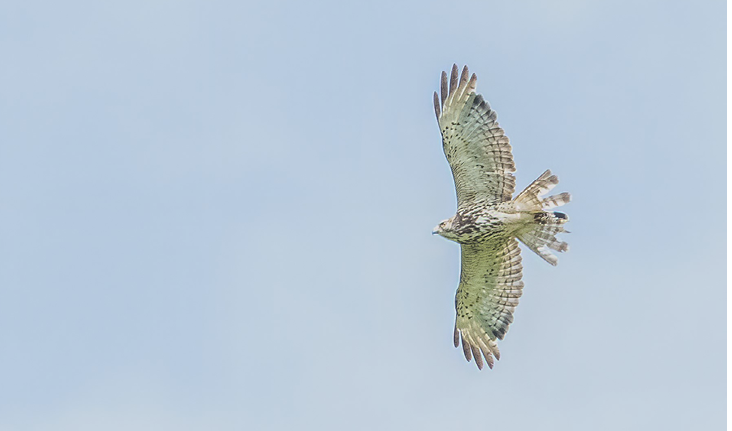Wayne R. Petersen

JOHN MISSING
Autumn is generally the premiere season to witness the majesty of southward hawk migration, so it seems appropriate that this issue's mystery bird is a raptor. Diurnal raptors (i.e., eagles, hawks, and falcons) are magnificent but often challenging to identify because (1) they are often observed only in flight at a great distance, (2) some species exhibit sexual dimorphism in size or coloration, (3) some species are polymorphic or exhibit regional variation, and (4) adults and immatures often have distinct plumages. Consequently, a brief or distant view of an unknown raptor can sometimes leave a question mark on a checklist or in a field notebook.
Shape and flight style are often key identification points when encountering an unknown raptor in flight. Are the hawk's wings wide and broad, do the trailing edges of the wings exhibit a bulge in the secondaries, and is the tail fairly short and fan-shaped compared to a chunky body? If so, these are features of a buteo—a group of large soaring species. In contrast, an accipiter, such as a Sharp-shinned or Cooper's hawk, will have more rounded and parallel-edged wings, a longer and more narrow tail in proportion to the body, and usually a smaller head in front of the wings. In flight, an accipiter typically alternates between several rapid flaps and a brief glide. Finally, if the wings and tail of an unidentified raptor appear narrow and pointed and the bird exhibits rapid and direct open-air flight, it is probably a falcon. Though flight behavior is important in the field, we need to turn to shape and plumage characteristics to identify the raptor in the still photograph.
The mystery raptor is clearly not an eagle because of its generally pale coloration and lack of massive head and bill proportions. Likewise, the mystery raptor's wings are not pointed at the tips and its tail does not appear to be narrow and pointed, which at once indicates that the bird is not a falcon. The short, fan-shaped tail and bulging secondaries on the trailing edge of the wings are not characteristic of an accipiter. By process of elimination then, the mystery hawk most clearly exhibits the characteristics of a buteo.
Assuming the hawk is a buteo, Red-tailed Hawk can at once be eliminated by the absence of a pronounced dusky bar on the leading edge (patagium) of each wing, and the lack of an unmarked white chest. A key feature to note on the mystery bird is the heavy and somewhat blurry streaking on the sides of the chest and marginally on the flanks (best seen in the online image). Equally significant is a white, relatively unstreaked area in the center of the chest. This white patch is often a hallmark of juvenile Broad-winged Hawks. Additionally, note the readily visible wide, dusky, terminal tips on the tail feathers, despite the heavy tail molt. And finally, notice the black tips on the fresh, incoming middle primary feathers. When this bird's molt is finished there will be a complete dark trim all around the outer edge of each wing—another leading feature of adult Broad-winged Hawks. A juvenile Red-shouldered Hawk, the species most similar in plumage to a juvenile Broad-wing, would exhibit subtly longer wings, have a slimmer tail, show finer and more extensive streaking on the breast, have a less distinct terminal tail band, and show clearly defined translucent crescents near the ends of the wings at the base of the primaries.
A final point in the photograph is the presence of a space or gap approximately five feathers in from the end of each wingtip. This gap is due to molting primary feathers, and when seen in a flying bird, the gap often gives the impression of a translucent crescent or window near the base of the primaries which can cause misidentification as a juvenile Red-shoulder. Yearling Broad-wings that show this stage of wing molt arrive in late May and early June, which is sufficiently later than the April arrival of immature Red-shoulders to provide a clue as to the correct identity. Collectively the features present in the photograph unequivocally indicate that the mystery hawk is a juvenile Broad-winged Hawk (Buteo platypterus) in its first-summer plumage.
Broad-winged Hawks are common to uncommon summer residents throughout Massachusetts, uncommon spring migrants in April and early May, and very common to occasionally abundant fall migrants in September.
John Missing photographed this yearling Broad-winged Hawk in mid-June 2020 in Ripton, Vermont.
Wayne R. Petersen